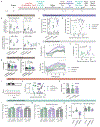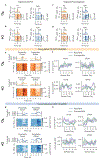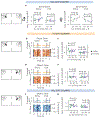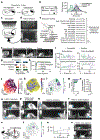Behavioural and dopaminergic signatures of resilience
- PMID: 36261520
- PMCID: PMC10026178
- DOI: 10.1038/s41586-022-05328-2
Behavioural and dopaminergic signatures of resilience
Abstract
Chronic stress can have lasting adverse consequences in some individuals, yet others are resilient to the same stressor1,2. Susceptible and resilient individuals exhibit differences in the intrinsic properties of mesolimbic dopamine (DA) neurons after the stressful experience is over3-8. However, the causal links between DA, behaviour during stress and individual differences in resilience are unknown. Here we recorded behaviour in mice simultaneously with DA neuron activity in projections to the nucleus accumbens (NAc) (which signals reward9-12) and the tail striatum (TS) (which signals threat13-16) during social defeat. Supervised and unsupervised behavioural quantification revealed that during stress, resilient and susceptible mice use different behavioural strategies and have distinct activity patterns in DA terminals in the NAc (but not the TS). Neurally, resilient mice have greater activity near the aggressor, including at the onset of fighting back. Conversely, susceptible mice have greater activity at the offset of attacks and onset of fleeing. We also performed optogenetic stimulation of NAc-projecting DA neurons in open loop (randomly timed) during defeat or timed to specific behaviours using real-time behavioural classification. Both open-loop and fighting-back-timed activation promoted resilience and reorganized behaviour during defeat towards resilience-associated patterns. Together, these data provide a link between DA neural activity, resilience and resilience-associated behaviour during the experience of stress.
© 2022. The Author(s), under exclusive licence to Springer Nature Limited.
Conflict of interest statement
Figures















References
-
- Cohen S, Janicki-Deverts D & Miller GE Psychological stress and disease. J. Am. Med. Assoc 298, 1685–1687 (2007). - PubMed
-
- van Praag HM, de Kloet ER & van Os J in Stress, the Brain and Depression 225–259 (Cambridge Univ. Press, 2004).
-
- Krishnan V et al. Molecular adaptations underlying susceptibility and resistance to social defeat in brain reward regions. Cell 131, 391–404 (2007). - PubMed
Publication types
MeSH terms
Substances
Grants and funding
LinkOut - more resources
Full Text Sources
Molecular Biology Databases
Research Materials

